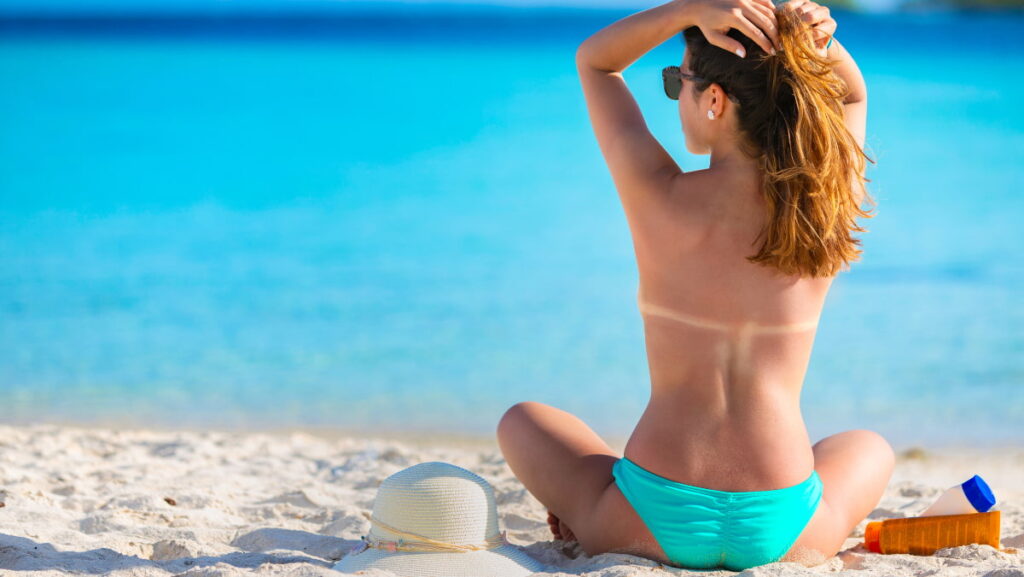
Like many of you, I’ve always loved the idea of sporting a sun-kissed glow. There’s just something about a golden tan that screams summer fun. But, as much as I adore basking in the sun’s warmth, I’m all too aware of the risks involved. Overexposure to the sun’s harmful ultraviolet (UV) rays can lead to premature aging, sunburn, or even skin cancer.
That’s why I’ve made it my mission to find the safest ways to achieve that bronzed beauty without compromising my skin’s health. In this guide, you’ll learn how to achieve that sun-kissed bronzed glow while minimizing the risks associated with tanning and how to tan without burning.
12 Tips On How To Tan Safely And Quickly
Before your tanning session, make sure to prepare properly. Preparing correctly before your tanning session is crucial in achieving a safe and even tan.
Firstly, exfoliation should be at the top of your pre-tan preparation list. Sloughing off dead skin cells through gentle exfoliation ensures an even canvas for your tan. This step prevents patchiness and helps achieve a smooth, more uniform tan that lasts longer. It’s best to exfoliate a day before tanning to avoid irritating the skin.
Hydration is another key factor not only for overall health but also for maintaining a beautiful tan. Thoroughly moisturizing your skin after exfoliating and before tanning helps prevent dryness that can result from UV exposure.
Well-hydrated skin will absorb and retain color better, leading to an evenly distributed tan that fades gracefully over time. Pay special attention to typically dry areas such as elbows, knees, and ankles, as these regions tend to absorb more color.
Now, let’s go over the 12 tips on how to tan without damaging skin below.

Always Use Sunscreen
Your skin’s safety is non-negotiable. Always slather on a generous layer of sun cream to protect those precious skin cells from UV damage. It’s your shield against the harsh effects of the sun.
Achieving that sun-kissed glow is a summertime goal for many, but it’s crucial to remember that your skin’s safety should always be the top priority. The sun, while being a source of vitamin D and warmth, emits ultraviolet (UV) rays that can cause significant damage to your skin cells if not properly protected.
This is where the importance of sun cream comes into play. Applying a generous layer of sunscreen acts as a protective barrier between your skin and harmful UV rays. It’s essential to choose a broad-spectrum sunscreen, which guards against both UVA and UVB rays, with an SPF of 30 or higher to ensure optimal protection. Reapplication every two hours or after swimming or sweating is also vital to maintain its effectiveness.
And remember, it’s a complete myth that you can’t tan when wearing sunscreen.
Apply The Right Sunscreen
Not all sunscreens are created equal. Look for broad-spectrum products with active ingredients that guard against both UVA and UVB rays. UVA rays can prematurely age your skin, causing wrinkling and age spots, while UVB rays can burn the superficial layers of your skin. Overexposure to either type can lead to skin cancer.
Choosing the right SPF (Sun Protection Factor) also plays a crucial role in keeping your skin healthy and happy under the sun. Dermatologists often recommend using sunscreen with at least SPF 30, which blocks out approximately 97% of UVB rays. However, if you have fair skin (less melanin[1]) or are prone to burns easily, opting for products with higher SPF might be beneficial for added protection.
Know How Long You Can Tan
Understanding your skin type is crucial. This knowledge tells you exactly how much sun your skin can handle before it waves the white flag. It’s all about finding that sweet spot where you get a tan, not a burn.
The first step in tanning is figuring out how to tan without burning. In order to do this, you should begin by knowing how sensitive your skin is to the sun, which different skin types can categorize:
- Type I – Always burn, never tan.
- Type II – Burn easily, tan minimally.
- Type III – Sometimes burns but tans gradually.
- Type IV – Rarely burns but tans easily.
- Type V – Very rarely burns and tans well.
- Type VI – Never burn; already have a deep natural tan.
Build Your Tanning Time Gradually
Start slow and build up your sun exposure gradually. This approach lets your skin adapt, reducing the risk of sunburn and ensuring an even, natural-looking tan. One key principle for safe tanning is patience. Rather than trying to achieve that golden glow in a single day, it’s much safer and healthier for your skin to start slow and gradually increase your sun exposure over time.
Starting slow means limiting your initial sunbathing sessions to short periods—think 15-20 minutes if you have fair skin—and then progressively adding more time as your tan develops.
This gradual approach allows your skin cells more time to produce melanin, the pigment that gives your skin its color and provides some protection against UV rays. By allowing this natural defense mechanism to kick in slowly, you’re not only minimizing the risk of painful sunburns but also ensuring that when your tan does develop, it’s even and natural-looking rather than patchy or burnt.
Avoid Peak Sun Exposure
The best times to enjoy the sun safely are before noon or after 3 p.m. Why these specific times? Well, during these hours, the intensity of UV radiation from the sun is significantly lower compared to midday when it peaks. In the morning and late afternoon, you’re less likely to expose yourself to harmful UV levels that cause burns and contribute to skin cancer risks over time.
But remember, even outside peak UV hours, protection should still be on your mind. Slather on a broad-spectrum sunscreen with an SPF of at least 30, wear protective clothing like hats and sunglasses and seek shade whenever possible. These steps add layers of defense against UV damage while allowing you to cherish the warmth without worry.
Take Breaks: Seek Some Shade And Cover Up
It’s crucial to approach tanning with a safety-first mindset to protect your skin from harmful UV rays, which can cause not only immediate damage like sunburn but also long-term issues such as premature aging and even skin cancer. This is where intermittent shade breaks come into play as an effective strategy for safe tanning.
By periodically slipping on a cover-up or popping under an umbrella, you give your skin essential time to rest and recover from the direct impact of the sun’s rays. Think of these breaks as a kind of reset button; they help prevent overexposure by giving your body a chance to more effectively regulate its melanin production.
Overexposure without these pauses can lead to sunburn, which not only damages the skin but can also put a halt to your tanning progress since peeling often removes much of the developed color. Plus, did you know that you can tan in the shade too?
Additionally, wearing protective clothing during these breaks further safeguards your skin by physically blocking out harmful UV rays.
Drink Plenty of Water
Drinking plenty of water is vital because it helps maintain your skin’s moisture levels from the inside out. When you’re well-hydrated, your skin appears plumper and dewier, which enhances the natural glow everyone desires with a tan.
Moreover, staying hydrated helps prevent premature aging signs like fine lines and wrinkles that can be exacerbated by excessive sun exposure.
Incorporating hydrating skincare products such as serums and moisturizers containing hyaluronic acid can provide an additional layer of moisture, helping to lock in hydration for longer periods. These products work by drawing moisture from the air into your skin, keeping it nourished even under the harsh rays of the sun.

Eat Sun-Friendly Foods
Boost your sun defense from within by snacking on sun-friendly foods. Load up on tomatoes, carrots, and guava. These goodies are packed with lycopene and beta carotene. Lycopene helps protect the skin naturally against UV rays[2] and beta carotene can help reduce sun sensitivity in people[3].
Eating water-rich foods like cucumbers, strawberries and watermelon can further enhance your body’s overall hydration levels.
| Sun-Friendly Food | Benefit |
|---|---|
| Tomatoes | Lycopene helps protect the skin |
| Carrots | Beta carotene reduces sensitivity |
| Watermelon | Hydration + Lycopene |
Move Frequently To Avoid Sunburn
Keep it moving! Shifting positions regularly helps ensure an even tan across your body without overexposing any single area. Think about it — nobody wants those tan lines or, worse, a burn that resembles the pattern of your lounge chair!
But let’s dive deeper into why this movement matters so much. By rotating and changing positions — say from lying on your back to lounging on your side or stomach — you distribute the sun’s impact more evenly across your body’s surface area. It’s all about moderation and avoiding prolonged exposure to intense sunlight.
After Sun Is Your New Bestie
After-sun lotions are not just regular moisturizers; they are specially formulated to address the needs of skin that has been exposed to the sun. These products often contain aloe vera or other cooling agents known for their soothing properties.
Aloe vera, in particular, is celebrated for its ability to hydrate deeply and calm irritation or redness caused by overexposure to UV rays. Applying an after-sun lotion generously can help replenish lost moisture and lock in the tan you’ve worked so hard to achieve. This not only enhances the longevity of your tan but also ensures that your skin remains healthy and resilient.
Here are a few of my person favorite after-sun products:
Don’t Mix Self-Tan With SPF
When it comes to achieving that perfect, sun-kissed glow without the risks of UV exposure, many turn to self-tanners as a safer alternative. However, an important aspect often overlooked in the quest for bronzed skin is the necessity of using sunscreen. Mixing your self-tanner with SPF might seem like a time-saver, but this is a big mistake.
The key ingredient in most self-tanning products is Dihydroxyacetone (DHA), which reacts with the dead cells on the surface of your skin to temporarily darken its appearance. Unfortunately, when DHA comes into contact with sunscreen, it can cause the SPF to break down more quickly than it normally would. This chemical interaction compromises the effectiveness of the sunscreen, leaving your skin vulnerable to harmful UV rays.
To ensure you get both the tan and protection you desire, it’s best to plan your tanning routine carefully. Apply your self-tanner at least a day before you plan on spending significant time outdoors. This allows enough time for the DHA to fully react with your skin.
After waiting 24 hours or so—during which you should also keep your skin well moisturized—you can then apply sunscreen liberally before heading out into the sun. Remember, even if you look like you’ve spent weeks vacationing in Hawaii thanks to your self-tanner, your skin is just as susceptible to UV damage as ever.
Avoid Tanning Beds
Seriously, just don’t do it. With indoor tanning skyrocketing the risk for all types of skin cancer, including squamous and basal cell carcinoma, it’s not worth the risk. Plus, the World Health Organization (WHO) has classified tanning beds as carcinogenic. According to Harvard Health, tanning beds emit UVA rays that are up to three times more intense than the UVA in natural sunlight.
Opt for spray tans or self-tanners with dihydroxyacetone (DHA) for a safer glow that looks just as fabulous. If you need help getting started with self-tanners, no worries; I’m a self-tan expert. Here, you can find the best self tanners that I’ve tested, and here I share how to self tan.
How Long To Tan On A Cloudy Day?
You may wonder if you can get a tan on a cloudy day, and the answer is yes! Clouds only block about 20-40% of UV rays, so tanning on cloudy days is still possible.
According to the Skin Cancer Foundation, up to 80% of the sun’s UV rays can penetrate clouds! So whether it’s sunny or cloudy, don’t skip the sunscreen.
Since tanning on a cloudy day is possible, it becomes important to consider how long to tan on a cloudy day. Your tanning time can vary depending on the thickness of the cloud cover, and generally, it might take longer than on a sunny day.
How Long Does A Tan Last: The Lifespan
A natural tan, acquired through sun exposure, typically endures for approximately 7 to 10 days until the outer skin layer naturally exfoliates, causing the tan to diminish.
Depending on the tan’s depth and your skin’s shedding cycle, it can persist for up to 30 days. It’s important to understand that increased exfoliation, sweating, or swimming can accelerate the fading of your tan.

The Risks Of Tanning
Tanning, either by spending time under the sun or using artificial tanning methods, might make your skin look sun-kissed, but it’s important to understand its associated risks.
When you expose your skin to ultraviolet (UV) rays, it can cause premature aging and skin damage and increase the risk of skin cancer like squamous cell carcinoma and melanoma.
Natural sunlight consists of two types of UV rays: UVA and UVB. UVA rays penetrate deep into the skin, causing aging and wrinkles, while UVB rays are responsible for sunburns. Both types contribute to the development of skin cancer.
Consider the following statistics for tanning risks:
| Risk | Statistic |
|---|---|
| Skin cancer | 1 in 5 Americans will develop skin cancer in their lifetime[4]. |
| Melanoma | Women younger than 30 are six times more likely to develop melanoma if they tan indoors[4]. |
| Everyone | Skin cancer can affect anyone, regardless of skin color[4]. |
Drawing Conclusions: A Safe Tanning Experience
Throughout this article, we’ve covered various aspects of tanning, and now it’s time to provide you with some key takeaways for a safe tanning experience. No matter what method you choose, it’s essential to keep your skin’s health in mind and prevent damage from excessive sunlight or improper tanning techniques.
One of the most important things to remember is how to tan properly and safely, so we quickly go over all the tips again. Make sure to:
- Always use sunscreen (SPF 30 or higher) and apply the right one for your skin;
- Reapply sunscreen every 2 hours or after swimming and sweating;
- Know how long you can tan and build your sun exposure gradually;
- Avoid peak hours (noon till 3 p.m.); seek some shade;
- Keep track of time spent outdoors, and don’t overdo it; take breaks;
- Wear protective clothing and sunglasses or use an umbrella;
- Drink plenty of water and eat sun-friendly foods;
- Move frequently to avoid sunburn;
- Pay attention to your skin and look for signs of redness or irritation;
- After-sun is your new bestie; make sure to apply this after a tanning session;
- Don’t mix self-tan with SPF, and skip tanning beds completely.
